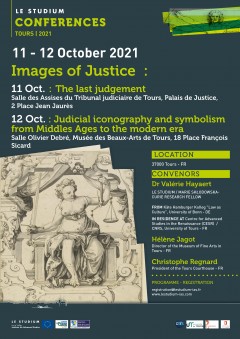We learned of a conference about judicial images and imaginary.
Conference description
In the last three decades, beginning in 1994 with a major work by Robert Jacob, there has been a renascence of writing of images of Justice, judicial iconography and courthouse architecture.
In 2016 and 2018, following two major exhibitions held in Bruges and Mechelen to which I contributed, I was able to weave a more reflective understanding of what happens when a viewer encounters an embodied image of justice, whether this artifact is a painting, a sculpture, or an object, trapped into a meaningful judicial ritual (eg. shaming practices, "amende honorable", executions in effigy).
These investigations were born out of a fruitful dialogue between curators, legal professionals and researchers. An image of justice is no longer imagined as an immobile artwork, or an opportunity for religious or historical narrative out of its primary judicial context but as an imaging process involving several functions (didactic, persuasive, mnemonic, deontological roles). In Europe, most of our contemporary courthouses are symbolically silent. A reflective evaluation of the functions of judicial images in the "longue durée" is a useful ally to revive the foundational principles of fair trial and due process.
Bringing together researchers and legal professionals, as well as curators and heritage specialists, this event also wishes to connect participants to the ways in which a figure of Christian Judgment has been constantly reinvented throughout the centuries. The idea is to look at artworks 'in situ' from a legal and societal perspective, explaining their key role as symbols.
Convenors
- Dr Valérie Hayaert, LE STUDIUM / Marie Skłodowska-Curie Research Fellow; from Käte Hamburger Kolleg "Law as Culture", University of Bonn - DE and in residence at Centre for Advanced Studies in the Renaissance (CESR) / CNRS, University of Tours - FR
- Hélène Jagot, Director of the Museum of Fine Arts in Tours - FR
- Christophe Regnard, President of the Tours Courthouse - FR
***
Last Judgment (salle d'Assises du Tribunal Judiciaire de Tours)
Chairman - Antoine Garapon (Sciences-Po Paris)
08.30 Welcome of the participants
09.00 Official opening by Sophie Gabillet (General Secretary of LE STUDIUM) & Christophe Regnard (President of the Tours Courthouse)
09.45 Valérie Hayaert - Regards sur le décor allégorique de la salle
10.00 Georges-Elia Sarfati (Professeur d'université (linguistique) et professeur d'études bibliques à l'Institut universitaire Elie Wiesel (Paris)) - Significations et portée de l'expression "le jour de Yahwé" dans la Bible hébraïque
10.45. Robert Jacob (directeur de recherche au CNRS et professeur d’histoire du droit à l’Université de Liège)
Chairman - Olivier Beaud (Paris II, Assas)
13.45 Christophe Bouton (Professeur de Philosophie à l’Université Bordeaux III-Montaigne) - Le tribunal de l'histoire - Le thème du jugement dernier dans les philosophies de l'histoire
14.30 Frédéric Gros (Professeur de pensée politique à l’IEP de Paris, Sciences-Po et chercheur au CEVIPOF)
15.30 Noëlle Herrenchmidt (journaliste reporter) : « 45 années de dessins d’audience aux côtés d’Antoine Garapon »
16.15 Antoine Garapon
17.30 Tribute to Antoine Garapon at the Basilique Saint-Martin (visit of the crypt and tribute on the square in front of the basilica: capacity of 60 to 70 people..
Sacha Philip (Émile Cohl school, Lyon) will sketch the speakers during the debates and will make an illustrated report of the day, in the tradition of courtroom drawings. The illustrations will be produced and filmed during the day, with occasional projections on a large screen.
08.30 Welcome of the participants
09.00 Offiicial opening by the director, Hélène Jagot, and the curator, Elsa Gomez (medieval and Renaissance paintings)
09.15 Valérie Hayaert - Deux tableautins (tavolette) encadrant le rituel d'exécution à Bologne (vers 1350) conservés au Musée des Beaux-Arts de Tours: l'image narcotique-salvifique dans le rite judiciaire.
10.00 Carolin Behrmann (Université de Berlin)
11.00 Dominic-Alain Boariu (Université de Fribourg, Suisse) - Autour du procès de Giuseppe Fieschi (1835) et son exécution ; Respondent: Raphaël Cahen (POLEN, Orléans)
11.45 Pierre Henri Biger & Samuel Devisme: La Justice sur un éventail : une allégorie critique de la politique judiciaire de Louis XIV ?
Chairman : Harold Epineuse (Institut des Hautes Études sur la Justice)
13.45 Manuela Bragagnolo (Max Planck Institute for Legal History and Legal Theory, Francfort) - Physiognomy and Law at the Early Modern Period ; Respondent: Concetta Pennuto (CESR, Tours)
14.45 Adrien Pitor & Nicolas Lyon-Caen - Assister à la scène judiciaire. Le public dans le Palais de Paris au XVIIIe siècle
15.15 Xavier Rousseaux (Université de Louvain) « La spectacularité des peines dans les Pays-Bas (rituels de pèlerinage ou de pardon, amendes honorables, ex-votos) au 15e-17e siècles. »
16.00 Stéphane Moure (MCF à la faculté de Droit de Tours) - « La nouvelle architecture judiciaire. Remarques sur un langage symbolique. »
16.45 Jean-Paul Jean (Président de chambre honoraire à la Cour de cassation et secrétaire général de l’AHJUCAF (Cours de cassation du réseau francophone) - « Le N’Kisi Kongo comme symbole de justice ».


No comments:
Post a Comment
Note: Only a member of this blog may post a comment.